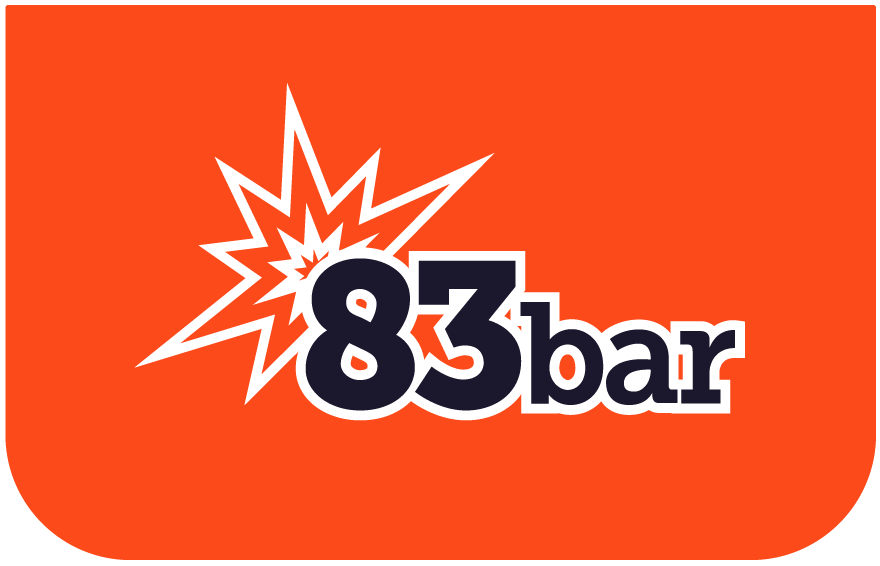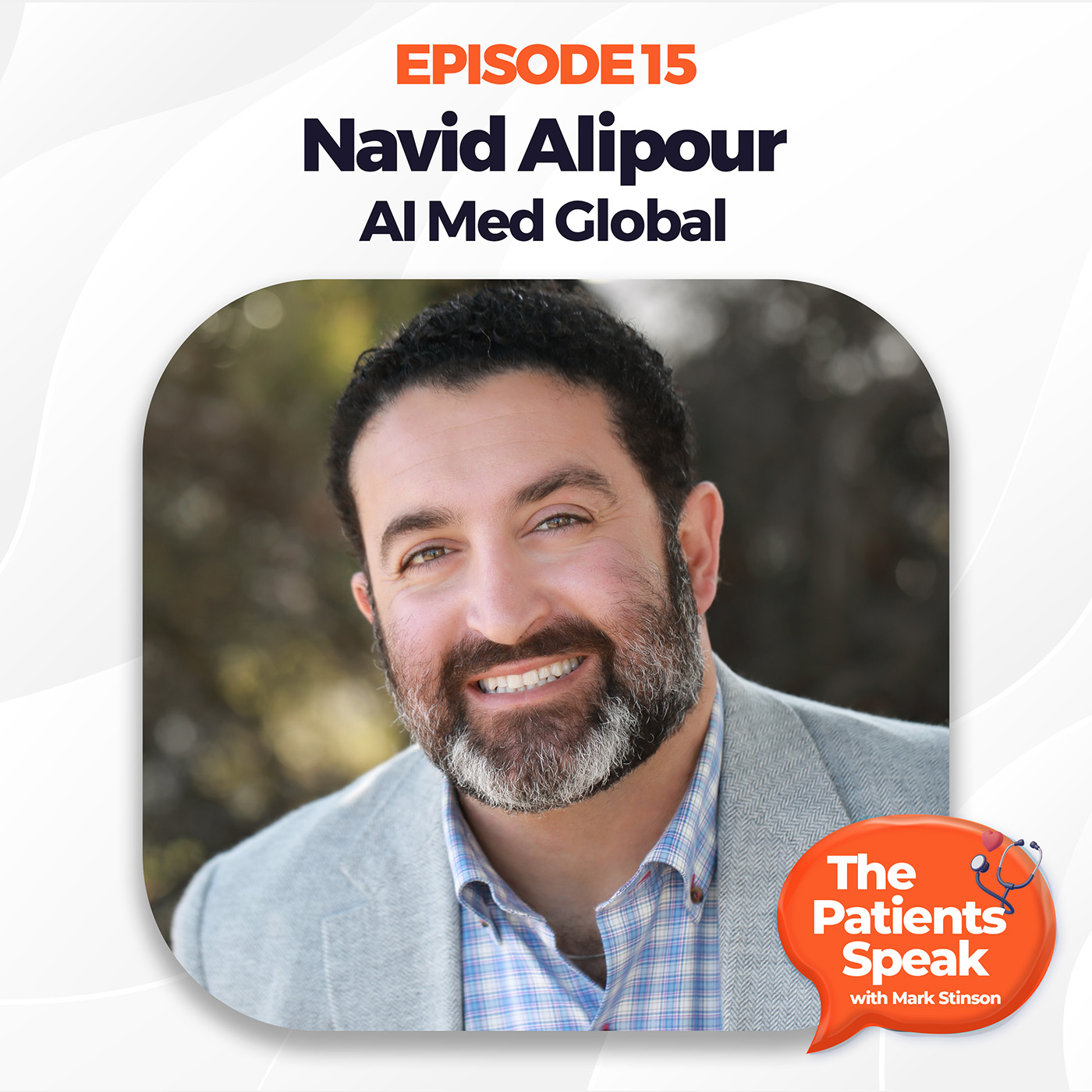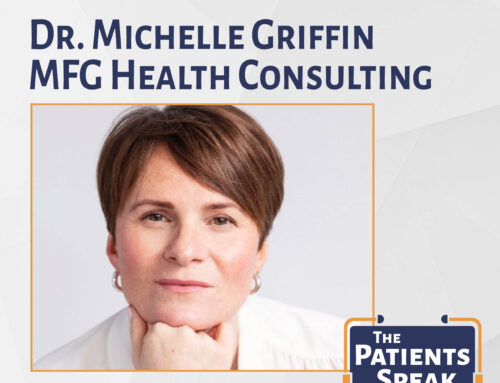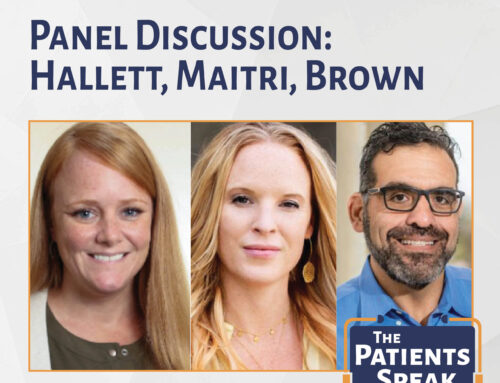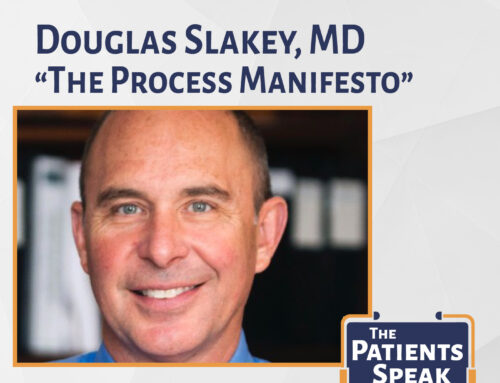Our guest today is Navid Alipour of AI MED GLOBAL. Today we take a look at how AI and precision personalized medicine, even medical imaging, converge with this idea of personalizing treatments.
Navid tells Mark about his business story and the technology behind his company, AI MED GLOBAL and CureMatch. Some of the main topics we talked about:
- How their AI technology creates faster results for early cancer detection
- How they level the playing field to CureMatch any patient. Making it easier for all patients no matter their background, economic or education gaps
- How AI Med Global works with Clinical Trials and what is KRR AI technology
Mark Stinson:
Welcome back everyone to our podcast, The Patients Speak. Today our topic is a real convergence of technology, medicine and science and even finance. Let’s take a look at how AI and precision personalized medicine, even medical imaging, converge with this idea of personalizing the treatments. I’m so happy today to be talking with Nave APO of ai, Med Global.
Navid Alipour:
Thank you so much for having me Mark. Very excited to be on your podcast.
Mark Stinson:
Well these are great topics and right from the start, as we think about the patients speaking, if we had a chance to talk to a patient that you’re serving, what is their biggest need?
Navid Alipour:
I think what I’ll preface it with is that we’re at an incredible point in history and modern medicine is going to advance more in the next 10 years than the last call it 50 years combined is the consensus. Now why is that gonna happen? It’s because of the advancements in the convergence of technologies that you mentioned. Artificial intelligence, precision medicine, genomics, more data and higher compute capacity to process that data. And that data by the way, is absolutely useless if you cannot collect it, clean it, refine it, and then produce an outcome. Now if you’re gonna, as oncologists say increase the PFS and the os, the progression-free survival or the overall survival of the patient, it’s all about better detection treatment and monitorings. Where we come in on the cure metric side is the detection where it’s our women’s health suite where we detect breast cancer and heart disease from the same mammogram.
No extra radiation, no extra discomfort. Early detection is, we all know it’s so critical, whether it’s colon cancer or heart disease or breast cancer, diabetes, that’s just so important to know as early as possible. So imagine if a woman at the age of 40 goes in for her first mammogram, she’s fit, she exercises, doesn’t have family history of heart disease and they tell her you have breast arterial calcification and now she can go to a cardiologist, know that she has that condition, get on statins earlier and again, just getting on the statins reduces a risk of a cardiac event by 50 to 60%. So that’s knowledge is power and that allowed decades of life to that individual. On the cure match side, it’s for patients that already have cancer and it’s not just women’s health, it’s pan cancer. So any cancer for man, woman or child.
And that’s where every cancer being different. As Dr. KRS Rock says cancer like a snowflake no two snowflakes ever look the same. And so to truly deliver the best optimal combination, it’s gotta be based on that patient’s specific molecular profile of their cancer. And so other companies in labs will do the biopsy and sequencing of that and produce their report, which is called NGS report and next generation sequencing report <affirmative>. And that’s our input. We take that in to then say out of the four and a half million combinations of drugs, here’s the best combination 1, 2, 3 for this specific patient as our decision support report for the oncologist to then review with the patient in the care of their situation and their cancer.
Mark Stinson:
Well it’s very exciting technology and it’s very exciting time in medicine for sure. And just thinking about it, I guess from the patient’s point of view, and you mentioned this one scenario of breast cancer and another one maybe of heart disease. Do the patients really know or can they are articulate what they’re looking for? Or is it a very general, hey I just need a treatment that’s designed for me?
Navid Alipour:
Well, it’s important to note that we wanna get as close to the patient as possible, but we are a technology company, we’re not a medical practice. So you have to be licensed to practice medicine. So even if we got a mammogram from a patient in Kansas City or in Idaho or in Seattle, we could look at that and our AI can detect if there’s cancer within a minute. But we can’t practice medicine and communicate that to the patient. It has to be a doctor licensed in that state to do that. Right <affirmative>, that’s where on the diagnostic side we look to get our technology into the hands of the radiologists and the imaging centers to then detect cancer faster to increase the workflow of their radiologists. There’s a huge shortage of doctors across the US but even down to specialists, mammographers a shortage. So our AI can turn that general radiologist into a specialist.
A junior radiologist can have the same results if not better, of a senior radiologist not using our AI or other technologies. So it’s important to note, we always say AI is not meant to replace the doctor, but the doctor using AI will replace a doctor that is not ultimately like the horse is left the stable for sure. Now on the cure match side, patients reach out to us all the time. They get cancer unfortunately they get on Google, they find us they word of mouth and so from all over the world and so on the cure match side, patients reach out to us all the time. We ask them to introduce their oncologist so we could then walk with them through the process of getting cure matched. We produce our report and with the 21st Century Cures Act, of course every patient that you and I, we all have the right to have our own information, be it blood work, be it an x-ray, be it a mammogram, be it a cure match report, but it’s Greek to them, they wouldn’t understand it. So you need the oncologist to go over the report with them and of course we’re happy to be in that conversation as well.
Mark Stinson:
Sure. Well, and to leap off that point, much has been written about the more educated patient, a more empowered patient, and this data certainly gives them more insight into their diagnosis. Is this translating into patient empowerment? In other words, you have more choices for sure, but now you have a decision power that you’ve never had before.
Navid Alipour:
It is. And the fact is that those that are socioeconomically better off, they tend to have more information available, they have better insurance, they can have relationships that might get them to the top oncologists at these esteemed institutions, the Mayos, the MD Andersons, the Morris Cancer Centers, the Johns Hopkins. And by the way, not to take anything away from the community hospitals. My wife is a 20 year Hodgkin’s lymphoma survivor and she went to Sharp Community Hospital here in San Diego and they took great care of her. But we all know that those really, really horrible nasty cancers, the community hospitals end up sending a lot of patients to these academic institutions. And so what we’re trying to do is level the playing field. So it doesn’t matter on someone’s background or wealth or education, we can cure match any patient, whether it’s at a Mayo or MD Anderson or at a community hospital in Des Moines, Iowa.
And so we actually do look to do a lot of outreach to community hospitals across the United States as well as to patient advocacy groups. <affirmative> the Hunter seven Foundation for example, is the advocacy group for veterans and those that have served in the military that have cancer. And so we offer complimentary reports every month to folks that the hundred seventh Foundation is helping that have served in have cancer. And so we look to partner with these advocacy groups to get the word out there to offer as our part of, even though we’re a small company, our are doing good and social impact, we give those five complimentary reports every month as our contribution. And we also worth noting we will cure match any child with cancer, any pediatric cancer at no cost. Years ago we had a child with cancer and the parents couldn’t afford our report and we said, Can’t not provide this and
Mark Stinson:
Well you’re really paint an interesting picture of, I’ll say bringing down to the community level, but really the AI and the data and the testing that you’re providing, the community level oncologist, it’s quite interesting that how it could level the playing field. I mean it’s always been a known fact that the more experienced or the more cases an oncologist would see, probably the more successful they are just because of that straight line of experience. The more patients you have, the better you get at it.
Navid Alipour:
Community? The short answer is yes. And the longer answer is that we work with the community hospitals just like a lot of the labs do, whether it’s the public ones like Garden or NeoGenomics or Foundation. So these labs using predominantly Illumina machines, but there’s others, Thermo Fisher of course, and Oxford Nanopore out of the UK and Element Sciences, there’s others. But they use that hardware in their labs to sequence the cancer biopsies. While a lot of these community hospitals are setting up their own CLIA certified labs because they want to take care of their patients right there in their community. So if they can have the lab themselves, they don’t need to send it elsewhere, they can maintain that revenue stream, take care of the patient, get them sequenced at that community hospital and then using Cure Match, they can take care of more patients potentially at their community hospital instead of having to send them hundreds of miles away, let’s say to MD Anderson if they’re in the state of Texas or yes or elsewhere, which is a huge stress financially for families emotionally to have that travel expense. It’s such a win across the board if you could take care of the patient in their own community.
Mark Stinson:
Well my guest is Navid Alipour of AI Med Global. I wanted to explore another part of the science and technology and that is in clinical trial recruitment and matching patients and recommending patients to the right trials as sponsor of this podcast 83 bar involved in that kind of patient outreach, activation and education. How does the tool help in that regard and let patients know what options there are for them?
Navid Alipour:
So a great question. While we are not a CRO and that works with pharma companies to do the clinical trials and find the patients, we can help the CROs and the pharma companies in selecting out of the core of patients that identified which arm will have a higher efficacy and they want in the trial to get the drug to market faster. And whatever you do, don’t pick this arm, they’ll have a toxic side effect, it’ll delay your trial. And so the win across the board is if we can help get a drug to market faster and it takes on average, I think 10 to 12 years for an oncology drug and a billion dollars or more. So if we could shorten that, patients will benefit faster. And of course the pharma company has the incentive of unlocking their intellectual property faster and saving costs on the trials as well.
Mark Stinson:
For sure. And in your experience, do patients see clinical trials as part of a treatment option? No, not just for research site, but does this really open the door to more patients participating?
Navid Alipour:
I believe it does. And we could include clinical trials and look at clinical trials of course in, but we only recommend on our cure match report drugs that are already FDA cleared. And so we can work with pharma companies with our clinical trial intelligence platform and the CROs to help select which patients will have the best efficacy to get that drug to market faster. But in regards to the cure match report we produce in our database, it’s a proprietary database we’re always curating and adding to. So as a new drug is FDA cleared, we of course add that and we have our own clinical team that does curation every day. Our chief science officer, Ali Perina, like Dr. Ku Rock is a rockstar of her own right. She was with Craig Vener the Human Genome Project at Human Longevity Inc. Developed oncology division that then NeoGenomics purchased and then went to the microbiome company before joining us. And so it also brings us to the type of artificial intelligence we use that is very unique that a lot of people haven’t heard of. It’s called K R R ai.
Mark Stinson:
Yeah, I’m glad you brought this up. I wanted to look under the hood of this cuz to say AI is to say oxygen right now. <laugh>.
Navid Alipour:
Yeah, it’s an, it’s overused in some ways and definitely has become a marketing spin where a lot of companies might slap it on their website or their materials and collateral, but it’s really just glorified business intelligence. So within the umbrella of artificial intelligence, you have nlp, natural language processing, that course our series and our Alexas, that’s nlp. And then you have machine learning that many people know about which at a very simple level you say this is a dog, this is a cat, this is kind of dog, this is this kind of cat. And you feed that into the system and it learns and can then identify what that’s a dog, that’s a cat. And then that applies to of course anomaly detection in the healthcare space where this is breast cancer, this is lung cancer, this is calcification in the arteries. And so the more images you have, the better.
So if you said Navid, here’s 10 million more mammograms. Do you want ’em? Of course I’ll take them. But there’s a diminishing rate of return with machine learning. Once you’re at 99% accuracy, which we are, how much better are you going to get in detecting that cancer where it’s very different on the cure match side. And that brings us back to that earlier comment that cancer like a snowflake, no two snowflakes look the same, No two cancers are the same. If they’re not the same, you can’t turn the AI to detect that cancer cuz it’s an N of one. That one patient’s cancer does not look like anyone else is at a molecular level. And so that’s where KRR AI comes in. It’s the same kind of technology behind gps. If you and I were both in New York City and we wanted to map to get to LaGuardia and we map one second after each other, we’re not gonna get the same results cuz traffic patterns are always changing.
So that built into the database curated that gets better and better than more it’s used. And so that’s where Dr. K Rock being esteemed, oncologist at her levels very careful of the words that come out of her mouth. But she’ll say we have a five to seven year head start and a competitive advantage that we’ll likely always maintain and it’s not about more money being thrown at it cause we have been added for so long and if anything, we’re going faster and faster and faster in that curation. So we have that proprietary engine, that database in the engine. And then when we get the patient’s NGS panel as our input, that’s all we need. We don’t need to connect to Cerner or Epic. Literally all we need is that 31 page PDF that they could email to us or the doctor’s office can enter on our website and we can turn around that cure match report in two to three days.
Mark Stinson:
Very good. Well Navid, I also wanted to talk to you about the business side of the equation here. Even on your website, you are flanked on either side with photos of your chief science and your chief medical and you in the middle it’s JD and MBA and your finance background. You’re not the coder, you’re not the technology guy and you’re not the science guy, but you’ve enabled all of the together. Where did the business story evolve for you?
Navid Alipour:
That’s a great question. I always joked that my wife and I are the black sheep of the families and that everyone’s a doctor. My father’s a retired cardiologist. My brothers are both doctors, my wife’s dad, her stepdad, her sister. So we’re the black sheep of the family that went to the law and finance side. That said, and the analogy I like to use is that a pilot on a flight has a couple hundred lives in their hands. Let’s say that air traffic controller though, and a 12 hour shift has thousands, right? And so I’m not a pilot, but I feel by getting these technologies out there in the hands of doctors and out to market and making patients aware of them, we can impact many more lives. And so what we identified from meeting the scientists at U C S D, which really one of the signers of artificial intelligence, and we started cure metrics with literally rocket scientists that had done work for NASA on the diagnostic for breast cancer detection at first.
And then my business partner, Blaze Barley, was diagnosed with cancer about two years into the history of that company. They basically said it’s a terminal cancer at the time. You have four years to live at best. Come back next week, we’re gonna start you on chemo. He didn’t really like the sound of that. And long story short, in doing his outreach and diligence, he met Dr. Krock and that’s how we ended up starting Cure Match. And so if he never had cancer, we would’ve never met her and this company wouldn’t exist. But once we met her and we saw what she was doing and the patients that she was helping to prolong their lives in some cases cure their cancers and eliminate the cancer, and we said, Dr. Kock, have you thought of starting a company? This technology belongs to the world and you can’t scale yourself. You can only see so many patients in one day. And so that’s where we combined her domain expertise with our artificial intelligence team to then train the algorithm to get it to where it is now.
Mark Stinson:
<affirmative>. And you’re telling a part of the story and I think about many healthcare startups out there, research organizations or technology or digital health, even in your ecosystem of San Diego, I mean there’s a healthcare and a biotech on every corner in San Diego that often are started from a personal mission, somebody in a family or even themselves with a condition. Do you feel like that personal mission and that commitment has a lot to do with all these companies, especially yours? It
Navid Alipour:
Has to. Absolutely has to. And I think not to take anything away from any other industry, but if you’re in the healthcare industry, it’s not just about making money. So you wanna make a difference, you want to make an impact. And every day we get up and say, how can we do things one day faster? Cuz that’s someone’s life that will potentially impact. And so for me personally, like I mentioned earlier, my wife is a cancer survivor, she has heart disease in the family. That early detection, that knowledge is power and that is will prolong lives and save lives. So our goal is, let’s see how we can do this faster. Cuz if we can detect at a global level, again, cancer and heart disease certainly don’t have borders or boundaries and neither do we do business internationally, but if we can detect calcifications earlier in women that that’s a tremendous, tremendous social impact we can have.
Cuz with heart disease specifically in women, 65% die on that first heart attack. Completely asymptomatic, no chest pain or shortness of breath like us men tend to have. We get to get to our doctors earlier, they tell us how bad we’ve been and we have an exercise or ate well and get you on statins and do the EKGs and stress tests. And hopefully it’s not so late that there needs to be surgical procedures. But if there is, you do it. But with women, they don’t have those symptoms. And so that’s where you can get a women at the age of 40 on her first mammogram and we can detect calcification as well. And it’s high enough where it merits getting her to a cardiologist to do those EKGs and stress tests and get on those statins. That’s a lifesaver. And again, just getting on the statin alone, man or woman reduces the risk of a cardiac event by 50 to 60%. So that’s why it just so critical. Detect as early as possible, what are, whatever the ails, but cancer and heart disease are the top two causes of mortality in the world. And that’s where we’re focused right now.
Mark Stinson:
Yes. And you mentioned all the various factors that come into play and I think about collaboration in this industry. There are a lot of co-research, co words, years all the time. Yes. And I think about the collaborations you might be looking for. The listeners of this podcast might be in pharma, biotech, diagnostics, medical providers. What are you looking for when you think about teaming up, make even more impact?
Navid Alipour:
I love that you brought that up. We can look at certain companies as competitors or we can look at ’em at them as partners and collaborators. So whole logic is the 800 pound gorilla in the women’s health diagnostics space. And they produce the machines that the packs that imaging centers and hospitals buy. And they have the CAD software as well, which of course that’s where we compete with them. But I look at them as a potential partner because they have the distribution. So if we partner with them to integrate our software with their machine, we’re gonna get it in the hands of more doctors faster. GE is the same whether Hologic or ge. On the cure match side, I mentioned companies like Garden NeoGenomics or Roche, which owns Foundation Medicine. So those labs, we do overlap in that they’ll do the sequencing and they’ll recommend some known combinations, but known combinations only represent 1% of the combinations out there.
So we’re the only company that looks at the 99% of unknown combinations and what they produce, some could say they’re a competitor, but I look at them as a partner because what they produce, their foundation report or their garden report, that’s our input. We take the baton and run with it from there, that’s where we wanna partner with them and all the way up to Illumina, which makes the machines that the labs use. So our report at the end here justifies selling more Illumina machines, getting more garden reports, more foundation reports and more CARIST reports. And so we look to partner with them so that we don’t have to reinvent the wheel <affirmative>, we can work with all of them. If they’re already at a community hospital, they say, you know that you could package their solution with ours to make it more seamless to help the patient faster and to eliminate a step there with the pharma companies as well. The example we talked about earlier is we wanna work with them to get their oncology drugs to market faster. So if anyone is listening that involved in pharma companies or CROs in the oncology space specifically, which is where we’re we’re focused with our clinical trial intelligence platform, we would love to talk.
Mark Stinson:
Well it’s a great way to approach the market thinking about these potential partners and collaborators rather than competition. Cuz I know based on my experience, the patient rarely knows all of these delineations, all of these boundaries, all of these separations, they just want to get better and they just wanna know how to get better treatment.
Navid Alipour:
From your lips to God’s ears that they have cancer. And it doesn’t just impact that individual, it impacts the whole family. They just want to know what is the best care that we can get and provide to our loved one. And if we can make it as seamless as possible and reduce some of that stress, then we’ve been successful.
Mark Stinson:
Very good. Now thank you enough for being on the show.
Navid Alipour:
Mark, it’s been a pleasure. Thank you so much.
Mark Stinson:
Thank you so much. His company is AI Med Global, and you can find out more about them@aimedglobal.com. And I’ll put all of these connections in the show notes so that you can find those. I’m Mark Stinson, come back again next time listeners, we’re gonna continue these conversations with healthcare executives, whether they be startups or multinational global companies. We’re gonna talk about, yes, their technology and their medical research, but more important, we’re gonna talk about how we connect with the patient and their needs for information and empowerment and what we hear when we listen to the patients speak. We’ll see you next time.
